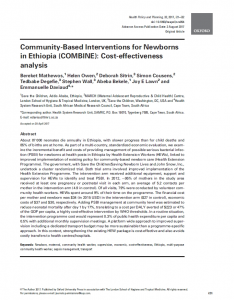
About 87 000 neonates die annually in Ethiopia, with slower progress than for child deaths and 85% of births are at home. As part of a multi-country, standardized economic evaluation, we examine the incremental benefit and costs of providing management of possible serious bacterial infection (PSBI) for newborns at health posts in Ethiopia by Health Extension Workers (HEWs), linked to improved implementation of existing policy for community-based newborn care (Health Extension Programme). The government, with Save the Children/Saving Newborn Lives and John Snow, Inc., undertook a cluster randomized trial. Both trial arms involved improved implementation of the Health Extension Programme. The intervention arm received additional equipment, support and supervision for HEWs to identify and treat PSBI. In 2012, ∼95% of mothers in the study area received at least one pregnancy or postnatal visit in each arm, an average of 5.2 contacts per mother in the intervention arm (4.9 in control). Of all visits, 79% were conducted by volunteer community health workers. HEWs spent around 9% of their time on the programme. The financial cost per mother and newborn was $34 (in 2015 USD) in the intervention arm ($27 in control), economic costs of $37 and $30, respectively. Adding PSBI management at community level was estimated to reduce neonatal mortality after day 1 by 17%, translating to a cost per DALY averted of $223 or 47% of the GDP per capita, a highly cost-effective intervention by WHO thresholds. In a routine situation, the intervention programme cost would represent 0.3% of public health expenditure per capita and 0.5% with additional monthly supervision meetings. A platform wide approach to improved supervision including a dedicated transport budget may be more sustainable than a programme-specific approach. In this context, strengthening the existing HEW package is cost-effective and also avoids costly transfers to health centres/hospitals.
*This article is part of a series of eight papers that includes the first multi-country, economic and systems analyses of community based maternal-newborn care. Access the series here >>